Menus
- MV Agusta F4 versus Bimota DB7
- Technology and driving behavior
- Concentrated strength of character
- Technical data Bimota DB7
- Technical data MV Agusta F4 1078 RR 312
- MOTORCYCLE test result
- Comments MOTORCYCLE scoring
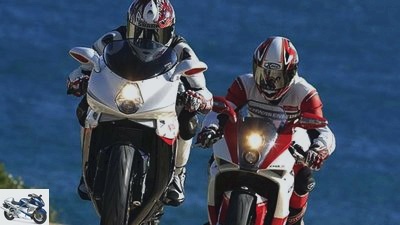
Gargolov

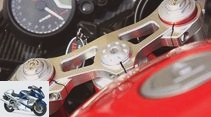

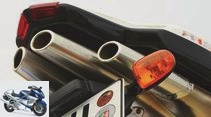
18th photos

Gargolov
1/18
The braking systems of both athletes are real delicacies. Compared to the MV, the brakes of the Bimota are more spontaneous, more powerful and easy to adjust. The brakes of the MV, although they are also one-piece brembos, require a little more temperature.
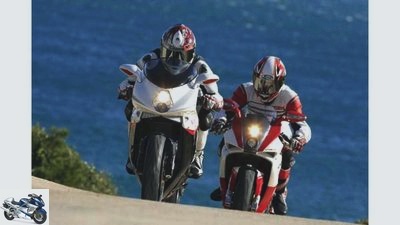
Gargolov
2/18
The MV has a higher peak performance, but the Bimota-V2 cuts a better figure in everyday life. It shines with an even power delivery and is more direct and cleaner on the gas. In addition, the load change reactions are lower in contrast to the MV engine.

Gargolov
3/18
Carbon from the fairing carrier to the monocoque. In addition a neatly milled fork bridge.
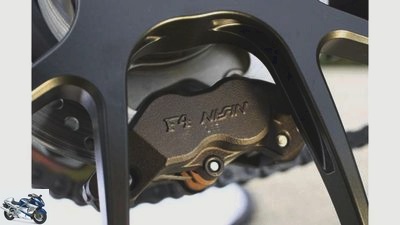
Gargolov
4/18
The rear brake caliper of the MV would be an ornament for each front wheel, the cleared spokes testify to the fight for every gram.
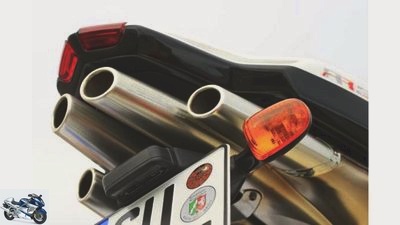
Gargolov
5/18
The trademark of the MV, the four exhaust pipes are still an eye-catcher.

Gargolov
6/18
On the MV, the pilot has to stretch powerfully over the tank to reach the low-mounted stub handlebars. The notches, which can be adjusted in height using an eccentric, only provide mild relief for the folded legs, even in the lowest position.
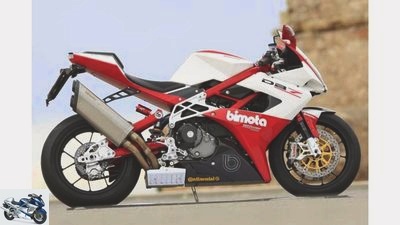
Gargolov
7/18
Only the finest detailed solutions can be found on the Bimota. The red and white paint suits her particularly well.
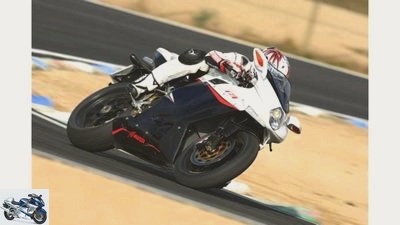
Gargolov
8/18
In terms of acceleration, the MV up to the 140 km / h limit is left behind compared to the Bimota, but the Bimota is nowhere near the top speed of 312 km / h.
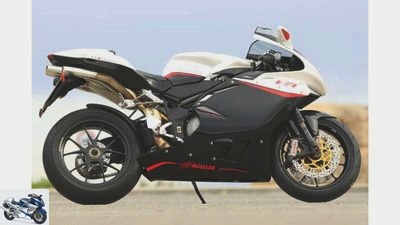
Gargolov
9/18
Even after almost ten years, the design of the MV Agusta F4 by no means looks old-fashioned. She is still a distinguished figure.

Gargolov
10/18
Colored anodized adjustment buttons on the strut of the Bimota. Tuning the shock absorber is not easy because the rebound and compression levels can be adjusted in the high and low speed range.
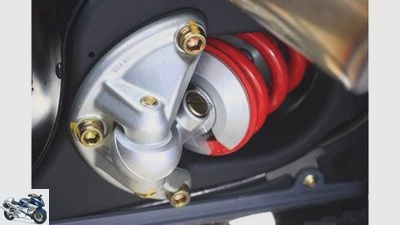
Gargolov
11/18
The MV is also enthusiastic. Even in places that you can hardly see, such as the screwed lower strut mount.
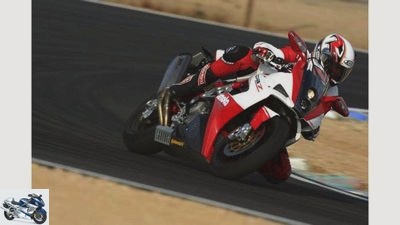
Gargolov
12/18
The Bimota takes all kinds of curves with the ease of a 600. Course corrections are child’s play for them. However, this maneuverability does seem a little nervous.
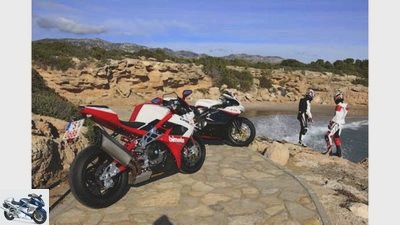
Gargolov
13/18
There are two beautiful Italian women and where are the testers looking?
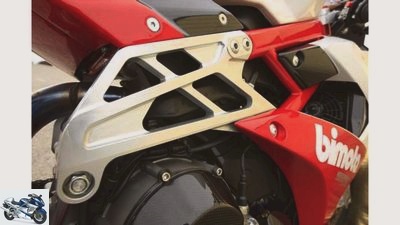
14/18
The red tubular space frame is complemented by exquisitely processed milled parts. Every detail on this motorcycle was made with the greatest care.
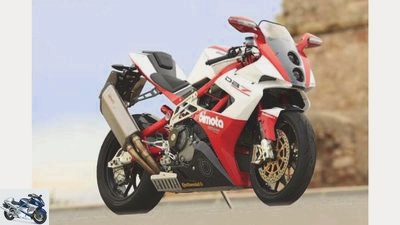
Gargolov
15/18
A feast for the eyes from every angle. Here the DB 7 lets us catch a glimpse of the dry clutch, which is only covered by a carbon fiber half-shell.

Gargolov
16/18
Bimota DB 7 and MV Agusta F4 1078 RR 312, both exclusive beauties with great detailed solutions, but which also have their price. At 22,690 euros, the MV is cheaper than the 26,656 euros expensive Bimota.
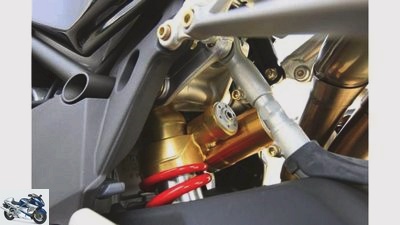
Gargolov
17/18
The rear of the MV can be adjusted in height using a push rod. The MV is also extremely stable thanks to the tight spring elements. However, it tends to take the curves further at the exit of the curve.
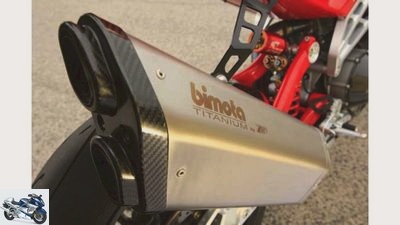
Gargolov
18/18
Anyone who is still thinking about an accessory exhaust cannot be helped. Zard titanium damper on the Bimota.
Comparison test, Bimota DB7, MV Agusta F4 1078 RR 312
MV Agusta F4 versus Bimota DB7
Italian motorcycle manufacturers have always known how to create fascinating and high-priced machines. The youngest representatives send Bimota and MV Agusta.
He was suddenly in the street. And he was the only one whom the two Italian beauties left completely unimpressed. The huge black mongrel dog didn’t even move as Bimota and MV rolled past him with irritated growls and cautious drumming bass. Anywhere else the two of them passed on this sunny, yet cool day in the south of France ?? Schools, markets, cafes or construction sites ??, children interrupted their play, police officers lifted their normally immovable sunglasses, construction workers let their shovels sink. Provocative, exciting, blessed with show talent, the Bimota. A treasure chest of shiny milled parts made of bare aluminum, painted bright red and white, with a tubular tubular arm. In addition, the contrast of the deep black carbon parts covered with several layers of clear lacquer.
Buy complete article
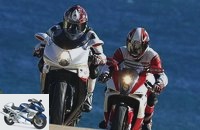
Comparison test
MV Agusta F4 versus Bimota DB7
DB7 does not fade the MV Agusta by any means. The design, which looks like a single piece, the fine lines and elegant appearance are still inspiring after around ten years. The pleasantly clearly drawn appearance exudes an elegant elegance, while the Bimota comes across as more technocratic, more loving to detail. But there is no bonus for beauty alone, which is why the Italian Graces also have to go through the bone mill of the test procedure. The two couldn’t be more different, that becomes clear when you climb up. On the Bimota, the driver locks into the seat like a plug into a socket. That fits, rests and handlebars at the optimal height, at the perfect distance from the seat. The stubs maybe spread a little too far outwards, but a narrow waist, a knee joint as if modeled.
In the case of the MV, on the other hand, it becomes clear that its design comes from a different era. Long and wide the tank, high the seat, even higher the pegs. The driver has to stretch a lot to reach the low-mounted clip-ons. The notches, which can be adjusted in height using an eccentric, only provide mild relief for the folded legs, even in the lowest position. That requires the ability to suffer. As a peace offer, the one with radial valves? on the inlet side made of titanium ?? Equipped row fours at the touch of a button. And flatters himself with this inimitable, rhythmically swelling and swelling sawing and grinding into the ear canals. Especially after very cold nights, the high octane does not go through the combustion chambers completely without occasional clearing of his throat for the first few hundred meters, but then he is wide awake.
Technology and driving behavior
Gargolov
Beautiful and glowing in a double pack: MVAgusta F4 1078 RR 312 and Bimota DB7.
Even the V2 of the Bimota, taken from the Ducati 1098 and equipped with a specially adapted injection computer, jumps to the standby position at the push of a button with a full, satisfied thump. Provided that it is handled with a sensitive gas hand, otherwise it will die offended and only start again after persistent plowing of the starter. What he then delivers, however, makes you forget the little bitchiness very quickly. Like a lion with its tamer’s whip, the V2 follows the instructions of the gas hand. He gets straight to the point with the slightest tug on the throttle valve. Now the Ducati 1098 goes from the state like a torpedo. But while with her the torque wave hits the rear wheel when a dam breaks, only to temporarily ebb away shortly afterwards ?? which unquestionably leaves the impression of unbelievable explosiveness ??, the appearance of the same drive in the Bimota has a completely different quality.
It is true that the DB7 is hardly less powerful from the low revs, but not as brusquely, with a smoother effort. And: where the Duc’s torque curve kinks, from 3500 rpm, the Bimota continues to power with the same penetrating power. Straight, easy to dose, linear. Despite the gentler use of power in the lowest altitudes, the DB7 lacks nothing in terms of dynamics compared to a 1098. On the contrary. The wide usable speed range is a boon. And that the revving pleasure from 8000 rpm may decrease a bit compared to a Ducati is of secondary importance in everyday life. The reasons for this change of character lie in the periphery of the V2. More precisely: the modified airbox and the exhaust system developed together with the Italian specialist Zard, including mappings devised by Bimota. Still, there is one fly in the ointment that is not too small: If the throttle valves are suddenly turned to draft below 4000 rpm, the V2 simply refuses to work.




40 photos
Pictures: comparison test
To home page

MV Agusta
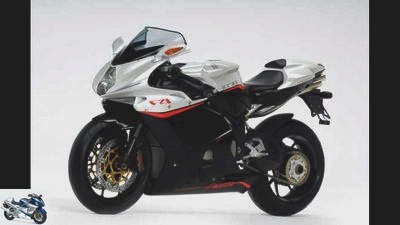
MV Agusta

MV Agusta
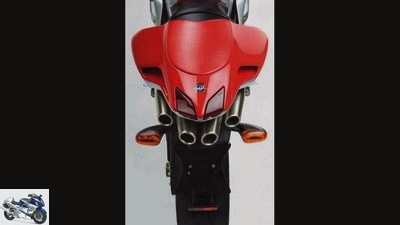
MV Agusta
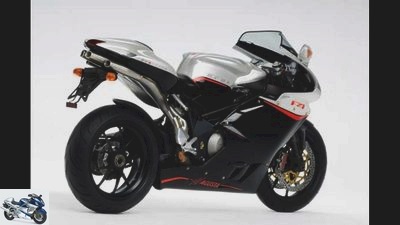
MV Agusta
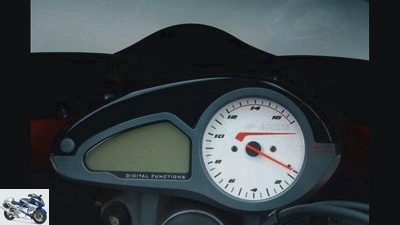
MV Agusta
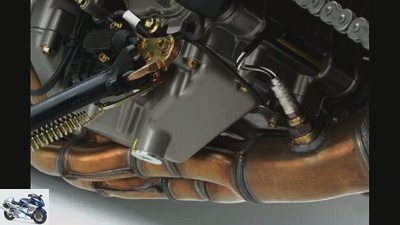
MV Agusta
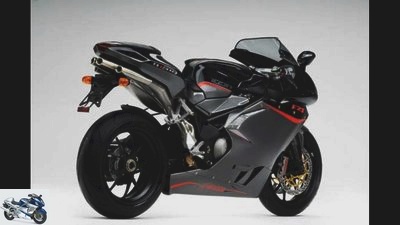
MV Agusta
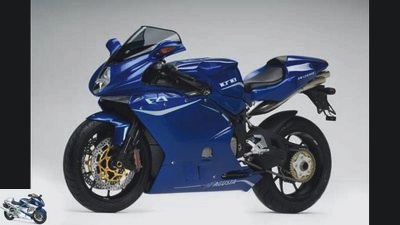
MV Agusta
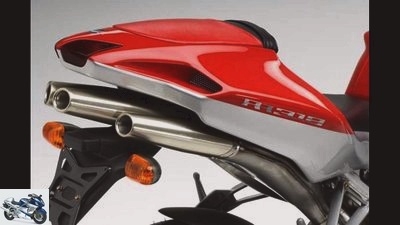
MV Agusta

MV Agusta
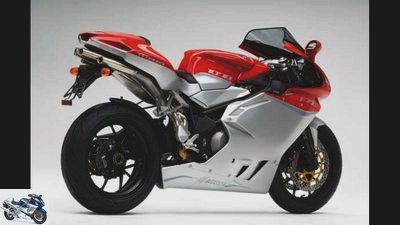
MV Agusta
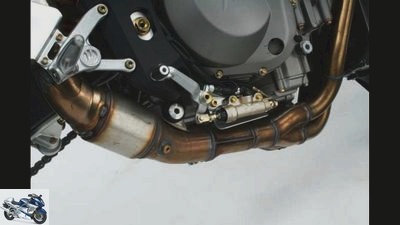
MV Agusta

MV Agusta
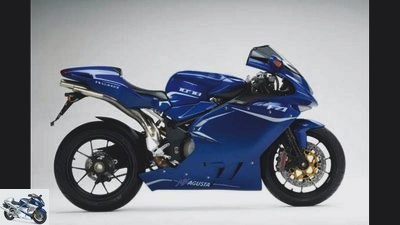
MV Agusta

MV Agusta
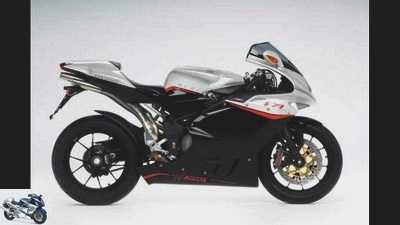
MV Agusta
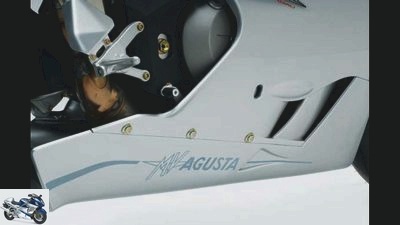
MV Agusta

MV Agusta

MV Agusta

MV Agusta
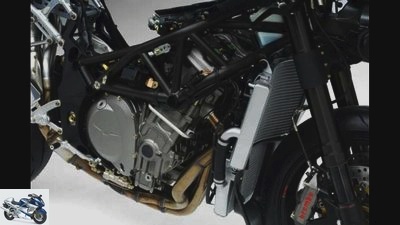
MV Agusta
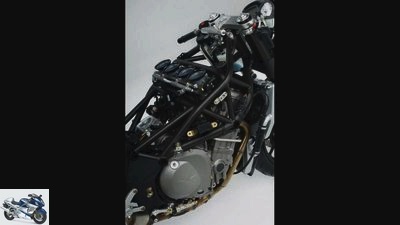
MV Agusta
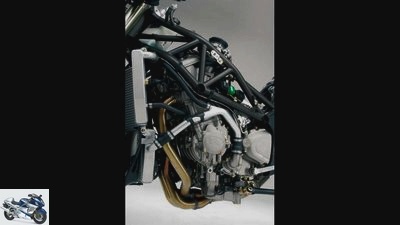
MV Agusta
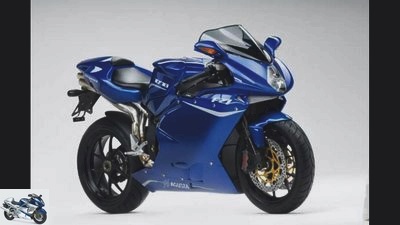
MV Agusta
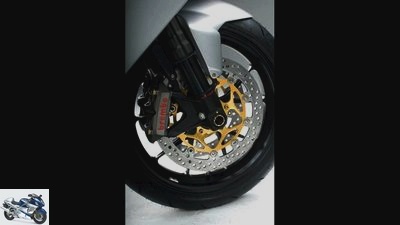
MV Agusta

MV Agusta
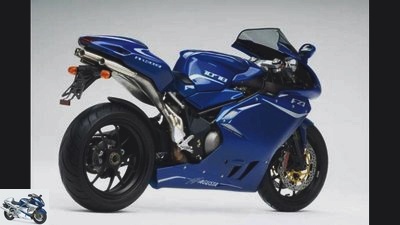
MV Agusta
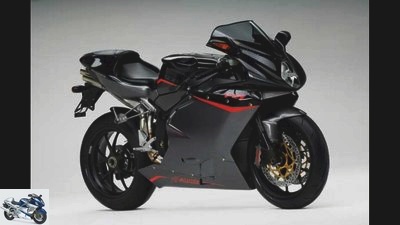
MV Agusta

MV Agusta
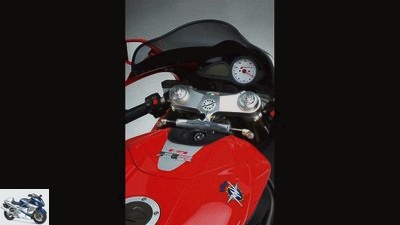
MV Agusta
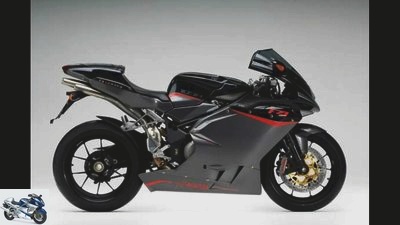
MV Agusta
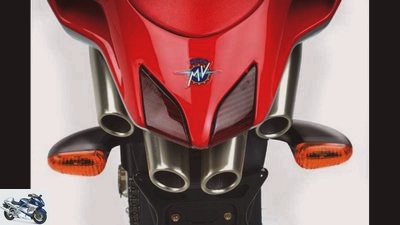
MV Agusta

MV Agusta
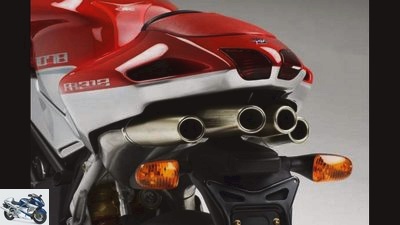
MV Agusta

MV Agusta

MV Agusta
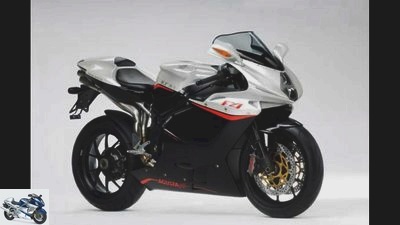
MV Agusta
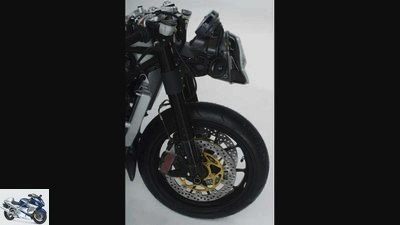
MV Agusta
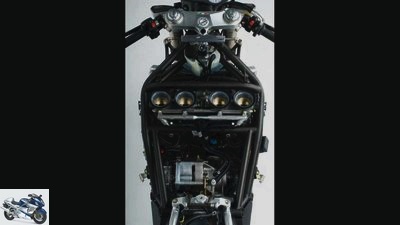
MV Agusta
Concentrated strength of character
Gargolov
Beautiful down to the smallest detail: MVAgusta F4 1078 RR 312.
There is plenty of it in higher altitudes. Likewise, the well-known hard throttle response, which is why the merciless thrust starts all the harder. A ticklish affair in an inclined position. It is probably time to thoroughly overhaul the dusty injection system with eight-hole nozzles and only one throttle valve per channel. The real purpose of the two, however, is the pleasurable nibble on combinations of curves of all kinds. And here, too, both reveal fundamentally different characters. The Bimota zips from one incline to the next with fascinating ease. It’s so easy that you can’t help comparing it to a 250. Okay, maybe that is a little over the top, but the comparison with a feather-light 600 certainly isn’t. The smallest steering impulse is enough to change direction. That leaves annoying sloppiness in detail such as the completely unusable mirror, the unprotected from boot heels and therefore jerky and nasty scratched right upper swingarm, the carbon chain guard knocked through by the whipping upper chain strand or the nicely milled, but angular and therefore badly in the hand hand lever temporarily take a back seat. Because even if it is surprisingly uncomfortable in a curve because it is tight, course corrections with the DB7 are a snap.
No wonder, with only 195 kilograms full, one might think. On the other hand: A Ducati 1098 S only weighs 196 kilograms. So it seems a lot more important where those pounds are. Because with a 65 degree steering angle and 100 millimeter caster, the chassis geometry of the DB7 is more conventional, the swing arm at 520 millimeters is only slightly longer than that of a Duc. But where it has a heavy rear frame with mufflers, the DB7 only has a feather-light, self-supporting carbon fiber rear. In addition, slender forged aluminum wheels for even nimble handling. However, the maneuverability of the DB7 is almost on the verge of nervousness. Because it reacts to every stimulus, whether intentional or coming from the roadway, it therefore easily picks up steering impulses from longitudinal grooves or joints. Compared to the graceful racehorse Bimota, the MV appears more like an express train. Storms steadfastly around corners on the chosen line, nothing and no one can put you off course. In and of itself, its handling is okay, even if it doesn’t set any records in the 1000’s. 222 kilograms and the underseat exhaust placed far from the center of gravity set limits. The wonderfully finished rear frame of the MV Agusta is stable enough for one passenger.




7th photos
Pictures: comparison test
To home page
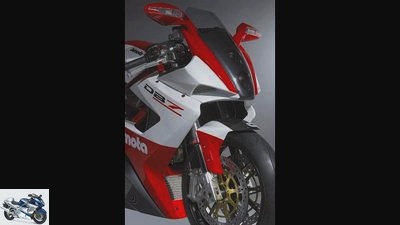
Bimota
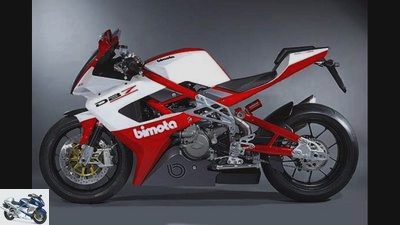
Bimota

Bimota
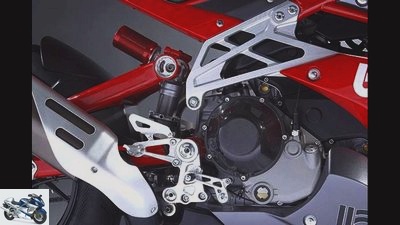
Bimota
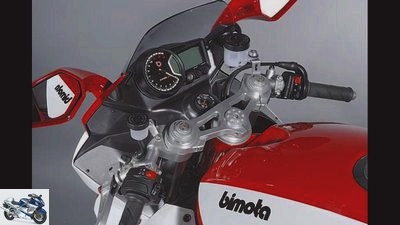
Bimota
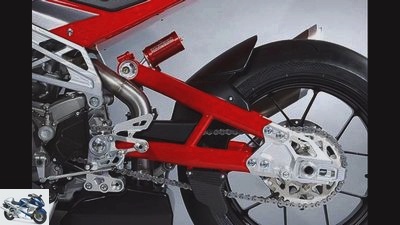
Bimota

Bimota
Technical data Bimota DB7
Gargolov
engine
Water-cooled two-cylinder four-stroke 90-degree V-engine, one overhead, toothed belt-driven camshaft, four valves per cylinder, desmodromic actuation, wet sump lubrication, injection, Ø 60 mm, regulated catalyst, 520 W alternator, 12 V / 10 Ah battery , hydr. actuated multi-plate dry clutch, six-speed gearbox, O-ring chain, secondary ratio 38:15.
Bore x stroke 104.0 x 64.7 mm
Displacement 1099 cm³
Compression ratio 12.5: 1
Rated output 113 kW (154 hp) at 9750 rpm
Max. Torque 118 Nm at 8000 rpm
landing gear
Steel tubular frame, load-bearing motor, upside-down fork, Ø 43 mm, adjustable spring base, rebound and compression damping, tubular steel rocker arm, central spring strut with lever system, adjustable spring base, rebound and compression damping, double disc brake at the front, Ø 320 mm, four-piston Fixed calipers, rear disc brake, Ø 230 mm, two-piston fixed caliper.
Cast aluminum wheels 3.50 x 17; 6.50 x 17
Tires 120/70 ZR 17; 190/55 ZR 17
Tires in the Continental Race Attack test
Dimensions + weights
Wheelbase 1435 mm, steering head angle 65.0 degrees, caster 100 mm, spring travel f / r 120/120 mm, seat height * 810 mm, weight with a full tank * 195 kg, payload * 105 kg, tank capacity / reserve 16.0 / 4.0 liters.
Two year guarantee
Service intervals every 12,000 km
Colors red / white
Price 26,656 euros
Additional costs around 295 euros
Technical data MV Agusta F4 1078 RR 312
Gargolov
engine
Water-cooled four-cylinder four-stroke in-line engine, two overhead, chain-driven camshafts, four valves per cylinder, bucket tappets, wet sump lubrication, injection, alternator 650 W, battery 12 V / 9 Ah, hydraulically operated multi-disc oil bath clutch, (anti-hopping), six-speed gearbox, O-ring chain, secondary ratio 40:15.
Bore x stroke 79.0 x 55.0 mm
Cubic capacity 1078 cm³
Compression ratio 13.0: 1
Nominal output 140.0 kW (190 PS) at 12200 rpm
Max. Torque 124 Nm at 8200 rpm
landing gear
Steel tubular frame, upside-down fork, Ø 50 mm, steering damper, adjustable spring base, rebound and compression damping, single-sided swing arm made of aluminum, central spring strut with lever system, adjustable spring base, rebound and compression damping, double disc brake at the front, Ø 320 mm, four-piston fixed calipers , Rear disc brake, Ø 210 mm, four-piston fixed caliper.
Forged aluminum wheels 3.50 x 17; 6.00 x 17
Tires 120/70 ZR 17; 190/55 ZR 17
Dunlop Qualifier RR tires tested
Dimensions + weights
Wheelbase 1408 mm, steering head angle 66.0 degrees, caster 104 mm, spring travel f / h 130/120 mm, seat height * 840 mm, weight with a full tank * 222 kg, payload * 196 kg, tank capacity / reserve 21.0 / 4.0 liters.
Two year guarantee
Service intervals every 6000 km
Colors red / silver, white / black, black / gray, blue
Price 22 690 euros
Additional costs around 250 euros
MOTORCYCLE test result
1st place: MV Agusta F4 1078 RR 312
Well done down to the last detail, with a powerful engine and excellent brakes, that makes up for weaknesses in engine tuning and ergonomics.
2nd place: Bimota DB7
It is a treasure trove of beautiful and elaborately processed details, of enchanting light-footedness and has a great engine, but also steep price.
Comments MOTORCYCLE scoring
engine
The two clearly show that performance is not everything. Despite the impressive top performance of the MV, the Bimota drive looks much better in everyday life. It depends more directly and cleanly on the gas, has fewer load change reactions, but above all, thanks to the even power delivery, pressure in all situations. The fact that his ability to turn is reduced at the top is not so important. The tight clutch is more likely.
Winner engine: Bimota
landing gear
The agility with which the Bimota masters curves of all kinds is astonishing. Somebody else would say, you can’t build a handy chassis around a Ducati engine. However, the DB7 is almost on the verge of nervousness. The MV Agusta shines with absolute faithfulness to the line and copes better with bumps. It is remarkable how sensitive the fork of the DB7 works. Overall, however, the vote of the general meeting is more balanced, and it also provides top feedback.
Winner chassis: MV Agusta
everyday life
Ergonomics is not the MV’s forte, the seating position is just exhausting. On the other hand, the seating arrangement, the knee joint of the Bimota, which is only available as a single-seater, is great. And their mirrors are a cheek. In addition, its large turning circle is annoying. Despite really fantastic details, chassis and add-on parts, the Bimota awards an outstanding rating in the processing criterion due to unnecessary defects in practice.
Winner everyday life: MV Agusta
security
The braking systems of the two come with the finest components and are a real treat. With slight advantages for the Bimota, whose system has a more spontaneous bite and an even more finely adjustable effect. However, she lacks the points from braking tests with a pillion passenger.
Safety winner: MV Agusta
costs
Exclusivity has its price. With the thirsty MV a high one due to their short inspection intervals and substantial working time requirements.
Winner Cost: Bimota
Price-performance
Both are expensive enough, so they don’t get a better grade than 4.0. Whereby the MV is the cheaper offer.
Related articles
-
Comparison of Bimota YB 11 Nuda and MV Agusta Lustale
Comparison of Bimota YB 11 Nuda and MV Agusta Lustale Strip community When two divas of the two-wheeled upper class get rid of their haute couture fumble…
-
Comparison test of the 1000 super sports car, part 1
Jahn Comparison test of the 1000 super sports car, part 1 The full program Lean, strong, ready for attack, the Suzuki GSX-R 1000 completes the field of…
-
Endurance test MV Agusta Turismo Veloce 800
MV Agusta 14th photos 1/14 “Comfortable, agile in curves, stable on the autobahn” is an initial verdict on the MV Agusta Turismo Veloce 800….
-
Jahn Top test Aprilia Tuono 1000 R Everything stays different The Tuono is not just a naked bike. It’s a super sports naked bike. She always was. But the…
-
Jahn Harley-Davidson test Sportster 1200 Nightster The competition can get jealous. Instead of chrome and luxury, Harley wants to convince with purism,…
-
Jahn 13 photos Suzuki 1/13 In black and yellow, the Gladius can compete with the Honda Hornet. Suzuki 2/13 The low seat belt was specially tailored to…
-
Comparison between KTM 1190 RC8 and KTM X-Bow
Gargolov 16 photos KTM 1/16 The Austrian car manufacturer KTM will also start on four wheels in 2007. The puristic two-seater named X-Bow is presented to…
-
Kawasaki Z 800 in the top test
j.kuenstle.de 15th photos 1/15 The Kawasaki Z 800 is the successor to the Z 750 and in the MOTORRAD top test. 2/15 Wheelie with…
-
Gargolov 17th photos Gargolov, Rossen 1/17 BMW S 1000 R.. Gargolov, Rossen 2/17 BMW S 1000 R.. Gargolov, Rossen 3/17 BMW S 1000 R.. Gargolov, Rossen 4/17…
-
Photos: Kunstle Test Ducati ST3 S ABS The one which Only the ST3 with a water-cooled three-valve engine and, very recently, G-Kat remained of Ducati’s…